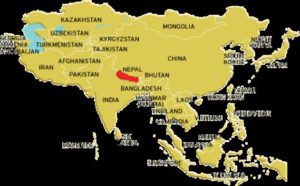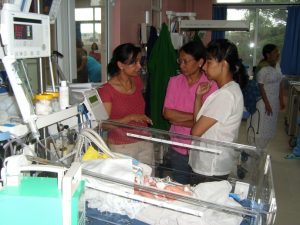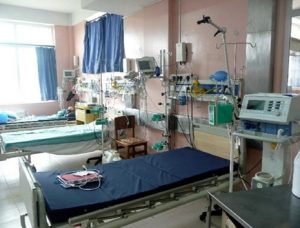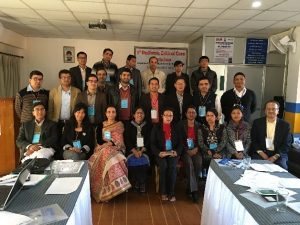PICU in Nepal
Many thanks to Sangita Basnet for sharing the article and photos of this project which is a wonderful example of collaborations between different institutions and countries. The main collaborators were:
- Lucile Packard Children’s Hospital, Stanford University School of Medicine
- The Children’s Hospital , University of Colorado at Denver and Health Sciences Services
- Southern Illinois University School of Medicine, Springfield, IL.
- Patan Hospital, Kathmandu, Nepal
A full list of trainers, educators etc can be found here
We’re also pleased to share more photos of the team involved and a special mention to the late Michele Avila a Nurse Practitioner who was also the VP of the ‘Friends of Patan Hospital’ (FOPH) but who sadly passed away suddenly in 2010.

The tiny picturesque country of Nepal lies between two giants, India and China, in South Asia. Over 40% of its 29 million population is under 15 years of age. One of the poorest countries in the world, a quarter of Nepal’s population lives below the national poverty line earning less than $1.25 per day.
Inspiration for a formation of a Pediatric Intensive Care Unit (PICU) in Nepal
In 1992, as a medical student of the only newly established medical school in Nepal, I was posted on a 3 month elective to a district hospital in the far west region of Nepal. At that time over 60% of Nepali lived below the poverty line and the infant mortality rate was almost 150 /1000 live births. I was on duty along with a “house officer” (who had just completed medical school in India), in the dingy, 4 bed emergency room.
It was night, almost end of my duty for the day, and I was thinking of ways to protect myself from poisonous snakes that were not an uncommon sight in this tropical village. Suddenly a woman carried in a 4 year old child who was gasping for breath, obtunded. I was frantic, asking the house officer to call for help. I could see that he was clearly at a loss too. We could not get hold of anyone who could manage this child. Some things in life you never forget. The picture of this child gasping for breath in a corner of the room until he passed away, with his mother quietly crying next to him, is ingrained in my memory all these years. This story repeats itself in Nepal. There is an overwhelming sense of fatality when confronted with critical illness.
Skepticism
The year 2002, as a fellow in pediatric critical care, my overarching goal in life was to introduce pediatric intensive care in Nepal. Needless to say, I met with skepticism. It would take resource away- I was told – from what is most needed, prevention, immunizations, nutrition. Reading about the history of pediatric critical care, I felt some relief that even pioneers in the field faced opposition when trying to introduce pediatric critical care in the developed world about 5 decades ago. ‘I held on (sometime by my fingernails) until others fell away, even if it sometimes took several years’ Dr. John J. Downes said, determined to build the first PICU in the United States at the Children’s Hospital of Philadelphia.
In 2004, I returned to Nepal to establish a PICU and teach pediatric critical care delivery. Even there the opposition was stiff. I went from hospital to hospital. I was ready to work without pay. I was confronted with suspicion and outright denial. I learnt the most important lesson in global health – demand or need in the local community is essential for success. Therefore I returned to the US and waited for opportunity.
Pediatric intensive care delivery in Nepal- Why?
It is true, according to the World Health Organization (WHO), preterm birth complications, pneumonia, intrapartum-related complications, diarrhea, and congenital diseases are the leading causes of death under 5 years of age in resource limited regions of the world. To achieve Millennium Development Goals (MDG4), WHO created guidelines, Integrated Management of Childhood Illness (IMCI), to manage patients in the ambulatory care setting. However, IMCI recognizes that up to 46% of these children will need hospitalization. There are reports from Malawi and Nepal showing that 70-80 and 50-62 per 1000 of these childhood admissions, respectively, result in death.
Training and education in critical care and critical thinking would probably improve care to these children because educated staff would have a greater vigilance to critical illness and provide essential care in the early stages of the disease. It would decrease the sense of fatality that providers experience when confronted with critically ill children. My argument is that it may even decrease global childhood morbidity and mortality.
And what about global justice? Why should a mother need to lose her child in Nepal to status asthmaticus and diabetic ketoacidosis just because that child was born in Nepal? And what if she could pay? Even then she would not be able to save her child in Nepal. Healthcare services are fundamental and universal human rights to be shared by the masses.
The PICU at Patan Hospital
Then in 2006, I heard through the grapevine that the chair of pediatrics at Patan Hospital, a tertiary care public hospital in Kathmandu, was looking at ways to build a PICU. I rushed to talk to her. It so happened that a philanthropist who loved Nepal wanted to build a maternity hospital with a neonatal and a pediatric ICU within the premises. At that time there was only one pediatric ICU in Kathmandu, in the only children’s hospital in the nation. Service was uncoordinated and informal. No one in the unit was trained in pediatric critical care and there was no way to even analyze blood gases.

In the summer of 2009, twenty two international experts including intensivists, neonatologists, pharmacist, respiratory therapist, nurse educators, and nurses visited Patan Hospital on a rotating basis to train 25 physicians and 25 nurses. A donation of $300,000 equipped the 6 bed PICU and 6 bed NICU with basic essential equipment and instruments. The units opened their doors after 3 months. The very first day, the first neonate, that would probably not have survived otherwise, was placed on the ventilator. They certainly are confronted with everyday problems including space, water, electricity, equipment, medications, diagnostic, training, and, above all, poverty. Nevertheless, the units are still providing care, the best in the nation, to critically ill children and neonates.
Newly established 6 Bed NICU at Patan Hospital

Newly established 6 Bed PICU at Patan Hospital

Expanding services
Education and training certainly has a ripple effect. We conducted the first annual Pediatric Fundamental Critical Care Courses (PFCCS) in Nepal in 2016. I met a number of the trainees from the 2009 PICU course. They said that they were so inspired by the training that they went to different parts of the country and started PICU and high dependency units in the hospitals they worked in. A recent report from Nepal shows that there are now 18 independent PICUs in Nepal, most established within the last 5 years, with almost 2000 admissions a year. Of course the problem of limited or complete lack of training and skill is still a major problem.
Future – Improving critical care delivery: This enthusiastic batch of young pediatricians wanted to start a Pediatric Critical Care Working Group with the objective to learn from each other and standardize management of critically ill children throughout Nepal. In November 2017 we had our first workshop. After brainstorming for 8 hours, the group put forth 2 protocols: standardization of sepsis and antibiotic use, and transport of the critically ill child.
1st Pediatric Critical Care workshop in Nepal

Pediatric critical care as a specialty in Nepal: July 2018, a pediatrician from Patan Hospital will be attending the 2 year pediatric critical care fellowship program at Kanchi Kamakoti CHILDS Trust Hospital, Chennai, India. She will be the first trained pediatric intensivist in Nepal. The demand for pediatric critical care is growing in the country. Hospitals want to establish PICUs, the population is demanding higher levels of care and care that is of international therapeutic standards. The need for a formal training program has arisen. Soon a 2 year fellowship will be established in Kathmandu.
Conclusions
The huge burden of critically ill children in Nepal demands equipped facilities and trained staff. There are challenges in Nepal that are unfathomable to us in the developed world. However, I believe optimal use of limited resources, early recognition, and critical thinking can contribute towards achieving the MDG4 that WHO has proposed. Additionally, there is now the opportunity created by a perceived need for critical care delivery among both general population and medical personnel. Our goal now is to channelize this need to make the process formalized, coordinated, and up to current therapeutic standards so as to decrease morbidity and mortality in Nepal’s children.
References
Mai CL, Schreiner MS, Firth PG, Yaster M. The development of Pediatric Critical Care Medicine at The Children’s Hospital of Philadelphia: an interview with Dr. John J. ‘Jack’ Downes. Pediatric Anesthesia 23 (2013) 655–664
Robison JA, Ahmad ZP, Nosek CA, Durand C, Namathanga A, Milazi R, Thomas A, Soprano JV, Mwansambo C, Kazembe PN, Torrey SB. Decreased pediatric hospital mortality after an intervention to improve emergency care in Lilongwe. Malawi Pediatrics. 2012; 130(3):e676–e682.
Basnet S, Shrestha S, Ghimire A, Timila D, Gurung J, Karki U, et al. Development of a PICU in Nepal: the experience of the first year. Pediatr Crit Care Med (2014) 15(7): 15(7):e314-20.
doi: 10.1097/PCC.0000000000000201.
Khanal A, Sharma A, Basnet S. Current State of Pediatric Intensive Care and High Dependency Care in Nepal. Pediatr Crit Care Med. 2016 Nov; 17 (11):1032-1040.
